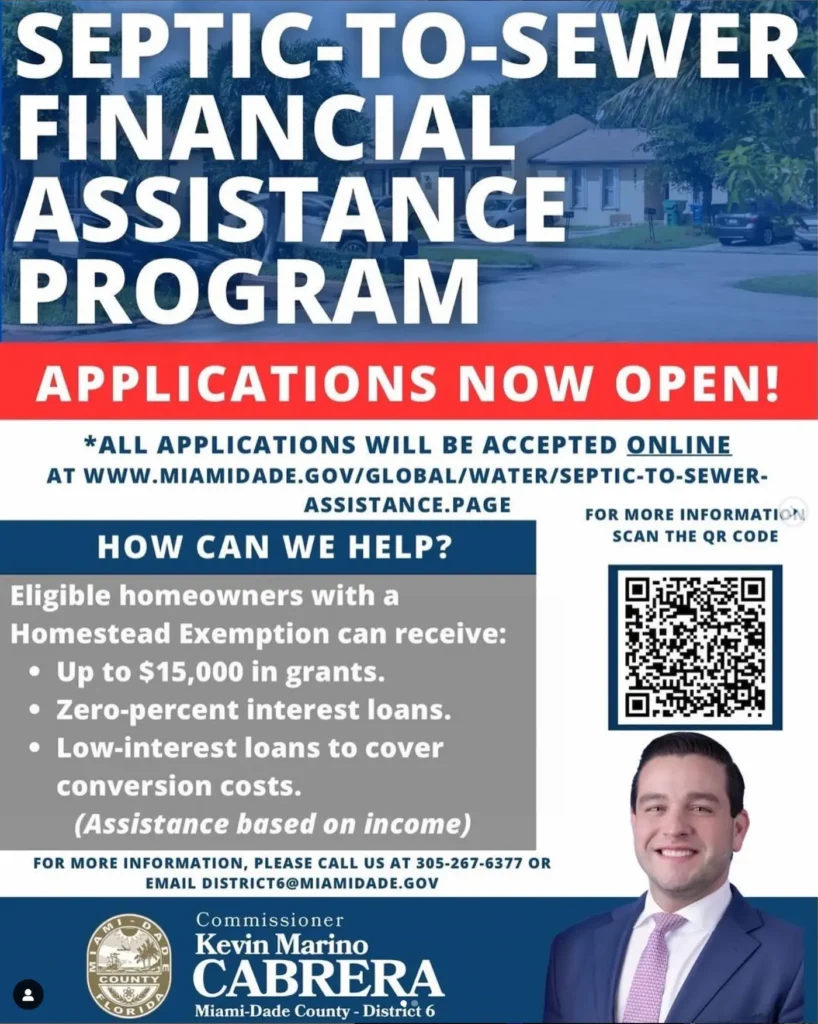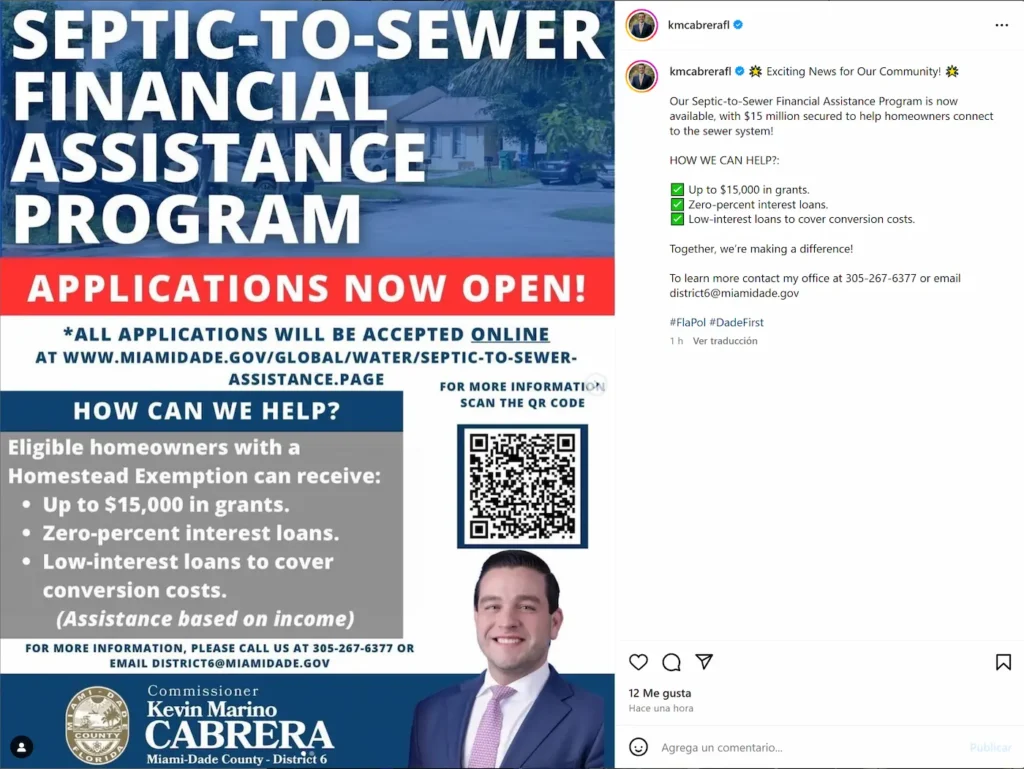|
Getting your Trinity Audio player ready... |
Tabla de Contenido/ Table of Contents
- 1 Kevin Cabrera’s Proposal on Sewage in Miami-Dade. The Lack of Sewage Infrastructure in Miami-Dade Neighborhoods
- 1.1 An Analysis and Reflection on Kevin Cabrera’s Proposal
- 1.2 Kevin Cabrera’s Proposal on Sewage in Miami-Dade
- 1.3 The Challenge of Sewage Deficiency: Key Questions
- 1.4 Why do some neighborhoods still lack basic sewage since 1926?
- 1.5 Will the current program effectively address the forgotten communities?
- 1.6 Is an individual request-based approach sustainable?
- 1.7 Why not implement a neighborhood-by-neighborhood strategic plan?
- 1.8 Is Miami’s urban planning aligned with its aspirations to become a modern city?
- 1.9 How does the lack of sewage affect public health and social equity?
- 2 Kevin Cabrera‘s Proposal: A Step in the Right Direction, but Is It Enough?
- 2.1 Kevin Cabrera’s Proposal on Sewage in Miami-Dade
- 2.2 How to Apply for the Financial Assistance Program for Septic-to-Sewer Conversion in Miami-Dade
- 2.3 1. Gather Necessary Information
- 2.4 2. Contact the Program
- 2.5 3. Complete the Application
- 2.6 4. Choose a Financing Option
- 2.7 5. Submit Your Application
- 2.8 6. Follow the Evaluation Process
- 2.9 7. Complete the Conversion
- 2.10 8. Take Advantage of Financial Support
- 3 Individual Solution vs. Collective Solution
- 4 Conclusion: The Need for a Comprehensive and Sustainable Plan
Kevin Cabrera’s Proposal on Sewage in Miami-Dade. The Lack of Sewage Infrastructure in Miami-Dade Neighborhoods
An Analysis and Reflection on Kevin Cabrera’s Proposal
The lack of sewage in various neighborhoods of Miami-Dade is an issue that has persisted since 1926 in some cases, raising questions about the effectiveness of public policies and infrastructure planning in the region. This situation not only affects the quality of life of residents but also highlights the need for a long-term solution that addresses the root of the problem, rather than applying short-term fixes.
Kevin Cabrera’s Proposal on Sewage in Miami-Dade

The Challenge of Sewage Deficiency: Key Questions
Why do some neighborhoods still lack basic sewage since 1926?
The fact that this issue has persisted for almost a century raises the question of why local administrations have not prioritized a comprehensive solution. If these areas have been identified as lacking sewage from the start, why haven’t definitive measures been taken to resolve it? Furthermore, it would be important to have precise data on how many neighborhoods still face this problem and how it has evolved since its initial identification.
Will the current program effectively address the forgotten communities?
Currently, the government has launched a financial assistance program that allows homeowners to connect to the sewage system. However, the question is whether this program will effectively address historically neglected communities. A reactive approach, where service is only offered when a neighbor requests a connection, may not be enough. A more proactive approach that considers long-term community planning and allocates resources where they are most needed would be more effective.
Is an individual request-based approach sustainable?
In practice, if the program only responds to individual requests, there is a risk that infrastructure will not be completed comprehensively, but rather temporary solutions will be provided. This could create disparities and would not address the issue structurally. It would be more efficient and fair to implement projects that address the needs of an entire neighborhood or even whole areas, rather than offering isolated solutions.
Why not implement a neighborhood-by-neighborhood strategic plan?
It is crucial for the county government to implement a strategic infrastructure plan that gradually covers all affected areas. While the current program offers assistance, there does not seem to be a clear strategy to address sewage infrastructure comprehensively. An approach that considers the needs of each neighborhood and its priorities would ensure a more equitable and effective solution.
Is Miami’s urban planning aligned with its aspirations to become a modern city?
Miami is in the process of positioning itself as a top-tier city. However, entire areas of the city lack basic services like sewage. How can a city aspire to be modern if it does not resolve its population’s fundamental needs? It is possible that prestige projects, such as skyscrapers and international events, are being prioritized while basic problems remain unresolved.
The lack of sewage in vulnerable neighborhoods has a direct impact on public health. Environmental contamination and health risks increase, especially affecting marginalized communities. It is essential that the county prioritize solving these issues in the areas most in need to ensure equitable access to essential services.
Kevin Cabrera‘s Proposal: A Step in the Right Direction, but Is It Enough?

Kevin Cabrera’s Proposal on Sewage in Miami-Dade
How to Apply for the Financial Assistance Program for Septic-to-Sewer Conversion in Miami-Dade
If you are a Miami-Dade resident and wish to convert your septic system to sewage, follow these steps to apply for the Financial Assistance Program for Septic-to-Sewer Conversion:
1. Gather Necessary Information
- Before starting the process, make sure you have the following documents ready:
- Proof of residence in the Miami-Dade area.
- Property information, including address and legal documents.
- Income documentation, if the program has economic eligibility requirements.
- Details about your existing septic system and the need for conversion.
2. Contact the Program
Contact the office responsible for the program to get guidance on the application process. Contact information is as follows:
- Phone: 305-267-6377
- Email: district6@miamidade.gov
3. Complete the Application
Fill out all the required forms with the requested information and attach the necessary documents, such as proof of ownership and, if applicable, any additional financial documentation.
4. Choose a Financing Option
The program offers several financial support options. Depending on your situation, you may opt for:
Grants of up to $15,000.
Zero-interest loans (0%).
Low-interest loans for additional conversion costs.
Select the option that best fits your financial needs and situation.
5. Submit Your Application
Submit the completed application and required documents via email or in person at the designated office. Make sure to confirm that your application has been received.
6. Follow the Evaluation Process
The office will review your application to determine eligibility and will notify you of the next steps, which may include inspections or technical evaluations.
7. Complete the Conversion
Once your application is approved, coordinate with authorized service providers to proceed with converting your septic system to the sewage system.
8. Take Advantage of Financial Support
The program will cover the conversion costs according to the selected financing option (whether grant or loan).
This program presents a great opportunity for Miami-Dade homeowners who want to improve their sanitation infrastructure with accessible financial support and benefits that facilitate the transition to a more efficient and safe sewage system.
Although the proposal is a positive step, several considerations must be taken into account:
Individual Solution vs. Collective Solution
The nature of the program, which responds to individual requests, may not be enough to effectively solve the problem at a collective level. The lack of sewage is not an isolated problem; it affects entire neighborhoods. Therefore, a more comprehensive approach, which includes planning and executing projects across entire areas, would be more efficient. Solving the problem neighborhood by neighborhood, starting with the most critical areas, would ensure that all residents can access the necessary services, instead of relying on isolated requests.
Gradual and Sustainable Approach
While the program offers financial assistance, true change will only be achieved if a strategic plan is implemented to address sewage infrastructure in the long term. Local authorities must present a clear action plan that covers all affected areas, without neglecting the most vulnerable communities.
Equity in Access to Basic Services
The lack of sewage mainly affects the most marginalized neighborhoods. The county must address equity in the distribution of resources and ensure that infrastructure projects are prioritized in the areas with the greatest need. Additionally, it is crucial that the county maintains transparency in the use of funds and resource allocation so that the community can trust that their interests are being properly addressed.
Conclusion: The Need for a Comprehensive and Sustainable Plan
The financial assistance program promoted by Kevin Cabrera is a positive initiative, but it cannot be the only solution to such a deep-rooted problem. The lack of sewage in neighborhoods that have lacked it for over 90 years requires a structural and long-term solution. Instead of relying on individual responses, an infrastructure strategy that gradually addresses all affected areas, starting with the most critical, is needed. Only then will Miami-Dade transform into a modern and equitable city, with access to essential services for all its residents.
Your Voice Is Crucial for the Future of Our Community!
Get involved in local decisions and be an active part of the change. Local policies impact every aspect of our daily lives, from the roads we travel to the health and education services we receive. Participating in local decision-making is essential to ensure our needs are heard and addressed. Don’t underestimate the power of your vote and opinion: make it count and contribute to the well-being of all! Act now because your community needs you!
Want more post like this?
Head over to our homepage for the latest updates from South Florida and beyond:








